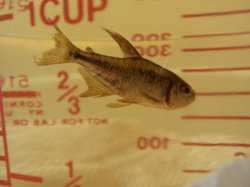lillykinloo
Fish Fanatic
- Joined
- Jan 12, 2007
- Messages
- 131
- Reaction score
- 0
Hi everyone. I have a female Diamond Tetra that seems to be ill and am hoping that I will be able to help her.
Tank size: 37 gallons
pH: about 7.2
ammonia: 0
nitrite: 0
nitrate: 5
kH: unsure
gH: 5
tank temp: 78 degrees
Fish Symptoms (include full description including lesion, color, location, fish behavior): General symptoms include poor coloring, lethargy, decreasesd appetite, red & swollen gills, rapid breathing, white stringy poo. In regards to poor coloring, she seems smaller than she did when we first purchased her (maybe this is a trick of the eyes), and she is not sparkly like the other Diamond Tetras. She is the smallest female of the group, but she used to have lavendar-grey scales with lots of sparkly scales as well. Now, she is mostly dark grey. The other Diamond Tetras have always been active swimmers with vigorous appetites. She seems lethargic and tends to stay towards the bottom of the tank where she is breathing a bit rapidly. She will eat, but she doesn't race to the top with her friends to gobble up anything and everything she can. She just eats 2-3 pieces that float to the bottom. Additionally, she doesn't hang out with the other tetras anymore. Yesterday, her gills looked fine, but my husband and I noticed the color change and that she didn't race to the top to eat. But today, her gills look red. They even look a bit swollen. She also has a fine white string hanging out of her-kind of like a white piece of poo (I don't know if this is related in any way, but I thought I'd mention it).
Volume and Frequency of water changes: 15-20% water change and a gravel vaccum weekly
Chemical Additives or Media in your tank: I use a water conditioner (Prime) with each water change
Tank inhabitants: 5 Diamond Tetras (2 female & 3 male), 3 Pearl Gourami (2 females and 1 male), 3 Striatum Killifish(2 females and 1 male) (I have closely inspected the other fish, and none seem to exhibit similar symptoms)
Recent additions to your tank (living or decoration): none
Exposure to chemicals: none that I am aware of
Thank you for any advice you can offer. I hope she is not beyond saving.
Tank size: 37 gallons
pH: about 7.2
ammonia: 0
nitrite: 0
nitrate: 5
kH: unsure
gH: 5
tank temp: 78 degrees
Fish Symptoms (include full description including lesion, color, location, fish behavior): General symptoms include poor coloring, lethargy, decreasesd appetite, red & swollen gills, rapid breathing, white stringy poo. In regards to poor coloring, she seems smaller than she did when we first purchased her (maybe this is a trick of the eyes), and she is not sparkly like the other Diamond Tetras. She is the smallest female of the group, but she used to have lavendar-grey scales with lots of sparkly scales as well. Now, she is mostly dark grey. The other Diamond Tetras have always been active swimmers with vigorous appetites. She seems lethargic and tends to stay towards the bottom of the tank where she is breathing a bit rapidly. She will eat, but she doesn't race to the top with her friends to gobble up anything and everything she can. She just eats 2-3 pieces that float to the bottom. Additionally, she doesn't hang out with the other tetras anymore. Yesterday, her gills looked fine, but my husband and I noticed the color change and that she didn't race to the top to eat. But today, her gills look red. They even look a bit swollen. She also has a fine white string hanging out of her-kind of like a white piece of poo (I don't know if this is related in any way, but I thought I'd mention it).
Volume and Frequency of water changes: 15-20% water change and a gravel vaccum weekly
Chemical Additives or Media in your tank: I use a water conditioner (Prime) with each water change
Tank inhabitants: 5 Diamond Tetras (2 female & 3 male), 3 Pearl Gourami (2 females and 1 male), 3 Striatum Killifish(2 females and 1 male) (I have closely inspected the other fish, and none seem to exhibit similar symptoms)
Recent additions to your tank (living or decoration): none
Exposure to chemicals: none that I am aware of
Thank you for any advice you can offer. I hope she is not beyond saving.


 /www.aquaessentials.co.uk/index.php?...products_id=138
/www.aquaessentials.co.uk/index.php?...products_id=138
